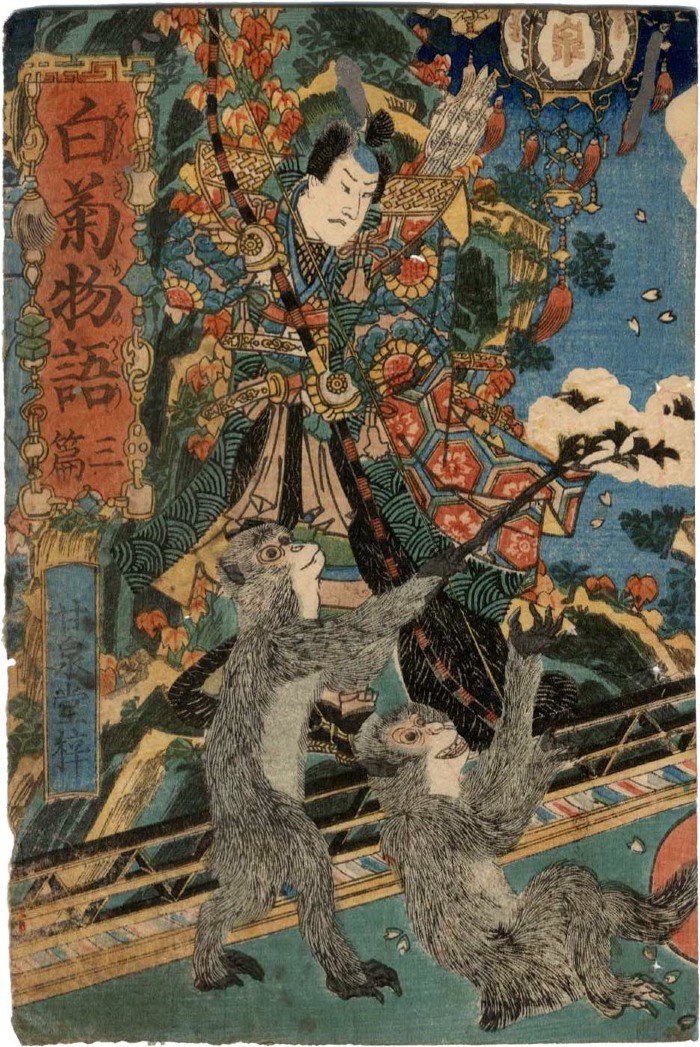Utagawa Yoshitora (歌川芳虎: ca. 1836-1887) (artist )
Ehon cover with warrior and monkeys - title: 白菊物語 (Shiragiku monogatari or 'Story of the Auspicious White Chrysanthemum')
1852
National Institute of Japanese Literature - in black and white - #68 - located at the Reitaku University Library (麗澤大学図書館) This is the left-hand panel of two ehon covers. See the attached jpeg to see the right-hand cover paired with it.
****
Shiragiku (白菊) or 'White Chrysanthemum' is a term often employed, even into the 20th century. In 1888 Ochiai Naobumi (落合直文: 1861-1903) published a famous poem entitled Kōjo Shiragiku no uta (孝女白菊の歌). The Shiragiku kai (白菊会) or 'White Chrysanthemum Society' was established in October 1903 to promote poetry. In 1924 Osaragi Jirô (大佛次郎: 1897-1973) published his first installment of the Kurama-tengu (鞍馬天狗), a series that ended in 1959. The main character Kurama-tengu is an alias of a hero of the old school, both progressive and immersed in tradition, whose allegiance was an overwhelming support for the emperor and not the bakufu or shogunal governing body.
As is the case of so many other background stories from the Edo period, this one of the Shiragiku monogatari remains a mystery to us. We know, or we think we know, the number of volumes in this series, who illustrated them - Yoshitora - and who composed the story and the poems - Ryokutei Senryu (緑亭川柳: 1787-1858), but beyond that we are at a loss to explain the imagery.
However, we do have clues as to the underlying theme or themes of this ehon in the first volume of the 20th century series of Kurama Tengu by Osaragi. In Scott C. Langton's 2000 master's thesis at Ohio State, 'A literature for the people: a study of the jidai shôsetsu in Taishô and early Shôwa Japan'. At the beginning, on a dark and stormy night, an orphaned, but noble young man, Munefusa, encounters our hero in the forest. At first they are at odds, but after Kurama Tengu watches Munefusa easily ward off an assault from two of Kurama's sword-wielding henchman, our hero is convinced of the nobility of the boy. Little did they realize that Munefusa, a ward of his evil uncle, the son of the deceased noble Muneharu, is the son of an old friend of Kurama Tengu. And thus an alliance is born.
And here is where we find out the connection to the title of the ehon cover featured in the Lyon Collection. Kurama Tengu tells Munefusa that there is a dilapidated retreat in the mountains that was once owned by his father and that is now said to be haunted. Kurama Tengu does not believe these rumors are true. So the two new friends make a pact to go there and to find out what is real and what is not about this story. That night they spend at this eerie place and in time figure of a ghost-like old woman appears seated by a well in which the bodies of two men were found. When the old woman fails to scare Kurama Tengu and Munefusa away, she reaches behind her and pulls out a bright red mask, the kind that is often worn by female demons in Noh theater. But Kurama Tengu is on to her. Soon another black clad companion appeared nearby. Kurama Tengu calls them both out. He tells Munefusa to go capture the female figure alive while he deals with her companion. Given no other choice Kurama Tengu dispatches the companion and then rigorously interrogates the so-called ghost, who turned out to be all too human. Just as the captured ghost is about to tell Kurama who has put them up to this ruse a slight dark clad figure appears and shoots an arrow through the throat of the soon-to-be informant, killing her. Munefusa chases after this assassin and captures them. He removes the hood and sees that it is a young woman who confesses to being the daughter of Munefusa's evil uncle Muneyuki. It is not that this young woman approves of what her father has done, but she felt obliged to prevent the old-woman from revealing how dastardly her father really is. She is ashamed of what she has done and this is where we learn her true identity: Shiragiku-hime. The princess says: "Even though he is an evil person, he is still my father."
picture book (ehon - 絵本) (genre)
warrior prints (musha-e - 武者絵) (genre)
